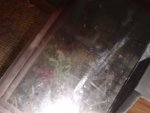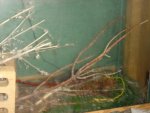I kept green anoles for most of my growing up years and through part of college. I had one last for over five years in captivity. They mated and produced eggs, but the female would often dig them up and eat them for whatever reason. They were healthy and lived well.
They ate a variety of foods. The vet who is an exotic animal vet had me feed them at least once a week with Mighty Dog canned dog food with powdered milk on it and a toothpick. You might be able to put it in a small bowl and watch them eat. They also ate a variety of fruit and rose petals, as long as the rose petals are grown where you know they are pesticide free (like on your own property). I used powdered milk on their fruit, but you can now get the calcium supplements and vitamin supplements to dust their food with. Just don't make it pasty or gummy. You might have to entice a non-eating anole with a moving food item on a toothpick or long feeding tweezer you can buy at the pet shop.
I fed them mealworms and crickets too, but he said that these have very little nutrition in them. Nowadays we can "gutload" them and I would recommend that. It is good to vary their diet since they would be eating all kinds of things in the wild. I caught them common houseflies and threw them in. Sometimes I would have to remove the wings so they could catch them easier. One time I gave one of them a pregnant fly which had maggots, and the vet said the anole had to eat the fly and maggots before the maggots ate the anole. There was nothing we could really do. The anole eventually won.
The thing I would worry about with them being outside in an enclosure is making them more available to predators. These little guys are escape artists, and when you put them outside, you are not only subjecting them to the elements and the extremes that can happen in temperatures, not to mention sudden flash floods, but you are also subjecting them to becoming to dry and not getting enough humidity too. I have yet to see them really drink much from a water dish. They much prefer drinking water droplets and if there are none, they can die of thirst and dehydration, and so would the crickets. Snakes and predatory birds would not find a screen much of a deterrent in getting to what they want either.
Just some thoughts. If you have questions, please contact me. :happy:
Have fun with your anoles,
Critter Mom





